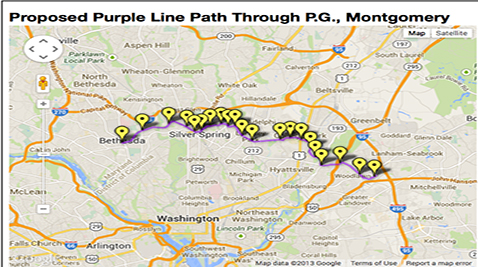RIVERDALE – Obdulia Rendon worries her children will have to attend a new school, her husband might have to get a new job and she might have to go back to work sooner than expected — all because construction on the Purple Line train will uproot her family from its home.
“I moved into my house 10 years ago, and I’m really not happy to have to move,” said Rendon, who lives along a stretch of road in Riverdale that lies in the path of the Purple Line. “I don’t want to sell. I like it here.”
More than 116 home and business owners are going to have to say goodbye to their property to make room for the new Purple Line light rail train. However, Purple Line Project Manager Michael Madden believes relocating residents and businesses to make room for the new train line will benefit the entire community by decreasing traffic congestion and making commute times faster.
The Purple Line will connect Bethesda with New Carrollton, and make stops at major population centers, such as the University of Maryland, Silver Spring and Takoma Park. The long-awaited rail line will receive funding from the federal government and Maryland, as well as from the private sector.
Construction is scheduled to begin in 2015, Madden said.
Rendon is just one of the 22 residents along Riverdale Drive, in a community located only a few miles from the University of Maryland, who is going to lose her home when construction on the new 16-mile commuter line begins.
Rendon transformed her backyard into a safe space where her children and their friends can play after school as she prepares dinner on the grill. She is uncertain that her new home will be a good fit for her kids, who enjoy playing in the backyard and easily getting to school.
Although some Maryland residents will be negatively affected, Madden is confident the new line will benefit the overall community.
Madden said the new line will offer improved connections to existing train lines, including the Metro’s Red and Green lines, and the MARC line to Baltimore. He hopes the new train will contribute to the economic viability of the neighborhoods where it will stop.
“A large majority of the residents we’ve spoken to are very much looking forward to it in terms of improved accessibility,” Madden said.
However, improved connections and faster travel times do not excite Rendon, who said she will no longer be able to move into a bigger house like she was planning on doing because her house was not valued as highly by an appraiser as she thought it would be.
Maryland will provide real estate agents and relocation counselors through the Maryland Transit Administration to help residents relocate when they are asked to leave their homes. Madden said residents will be offered the market value price for their homes, as well as compensation for moving costs.
Appraisers working in conjunction with the Maryland Transit Administration will visit each property to determine its value before the state offers property owners any money.
Rendon was uncomfortable saying what her home is currently valued at, but said it was $30,000 less than she thought it would be.
“My family is growing up. I wanted to move into a newer, bigger house but now I can’t do that,” said Rendon, who refinanced her mortgage to complete her payments faster. Rendon planned to sell her current house after the mortgage was paid, and use the money to buy a new house, as well as save for her daughter’s college tuition.
“After the house was paid off I wanted to work to save money for my daughter to go to university,” she said.
Madden also hopes the new public transit option will help spur economic growth in less developed areas and “help established areas in terms of economic viability.” However, some business owners who are being asked to move to make room for construction remain skeptical.
Austin Lee owns the Spring Discount Beer and Wine store in a strip mall in Silver Spring that will be displaced when construction on the Purple Line begins. After owning the store for eight years, Lee is nervous to move to another location where his store name is not already established.
Lee relies on the foot traffic that the Silver Spring strip mall brings in to draw business to his store. He is worried that moving to a new location will negatively affect his business.
“There are beer and wine stores on every corner, we can’t just move anywhere,” he said. “Retail is all about location, and we’re taking a huge risk by relocating our store.”
Despite relocating homes and businesses, Madden said the Maryland Transit Administration is working closely with residents and business owners to ensure the new train line does not disrupt life in the community when construction is complete.
The new light rail system will be quieter than the Washington Metro trains, Madden said. The Maryland Transit Administration will also provide noise panels in areas where the train will pass close to residential areas, however, some of the noise from the train will still be audible, Madden said.
Brigitte Mohamed works at Famous Pawnbrokers in Silver Spring, which will have to move for the Purple Line. She said the shop’s management has continued to operate the store as they normally would, but her customers do not want to see the Purple Line disturb their neighborhoods.
“I talk to people everyday and they say they will fight the to keep the Purple Line out of their neighborhoods,” she said.
Although she is frustrated about having to move away from Riverdale Drive, homeowner Allison Gills is relieved the Maryland Transit Administration decided to buy her entire property instead of building the new line just a few yards from her door.
“We can’t live here with the train coming through, that’s for sure,” she said. “If we have to move, we’ll move.”

